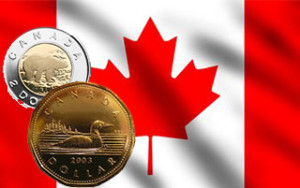Canadians are surprised, and rightly so. Their currency, the Canadian dollar or the loonie, as it is known for the iconic loon on the 1 dollar coin, has hit historic lows. It seems that there is no end in sight for the loonie’s demise, given that it is close to an all-time low of 62 cents against the US dollar. In fact, some analysts point out that since the currency started floating freely in 1971, this has been its steepest decline. Long gone are the days of parity with the US dollar, and Canada’s southern neighbor has a lot to do with its currency’s decline.
It was the advent of shale oil technology and the quick growth in that industry that ultimately shocked oil markets and triggered a supply war with Saudi Arabia. The Saudi’s, knowing that shale oil and Canada’s bituminous sands are much more expensive to exploit than their own reserves, has hiked supply to drive high cost producers out of the market. Not only is Saudi Arabia’s oil cheaper to produce, but it is also lighter and sweeter, which means that it trades at a premium price compared to the heavier bitumen in the great white north.
When oil plummets, the currencies of the countries that produce it follow suit. The reason behind that is simple. Oil is traded in US dollars, so when Canada sells its oil, US dollars flow into its economy. A few years ago, dollars were flowing in even though Canadian oil was being sold roughly at a 20% discount compared to WTI. The Canadian economy had enough US dollars coming in to push the value of its currency up.
But this is not the only the tip of the ice berg (mind the pun). Once a country’s currency appreciates, its exports become more expensive. Furthermore, with the oil industry doing well and offering great salaries, a lot of the workforce shifted away from other industries into the oil industry. This is called the Dutch disease, and Canada became one of its most critical patients. As a result, once oil started declining rapidly, all the other sectors in the economy, especially the manufacturing sector, were already hollowed out and unable to react to the more favorable exchange rate for exports.
This has kept the value of the loonie down, and since oil prices are still declining, Canada will feel even more pain. But at a certain point manufacturing will snap back, and the exchange rate will react. If the Bank of Canada keeps interest rates steady, the loonie will be pretty close to its bottom. That means that going forward, the Canadian dollar will be poised for a long term recovery, if Canadian manufacturing picks up.
Investors should be watching out for the following indicators before they make their decisions on the USD:CAD pair:
- Price of oil cannot go much lower, but if it keeps on falling, the loonie will follow, albeit less dramatically than up to now.
- Today the Bank of Canada will announce its decision on interest rates. If they lower interest rates, making borrowing cheaper, they will flood the economy with Canadian dollars and the loonie will fall further.
- China is critical. If its economic growth doesn’t pick up, the loonie will face downward pressures in the short term.
- Canadian manufacturing data. If export led manufacturing picks up, the loonie will regain value over the medium term.
- The Saudi-Iranian oil-powered spat. This is a tricky one: if it leads to an escalation and further conflict in the Middle East, it will create upward pressures for the price of oil, possibly helping the loonie stabilize and strengthen a little. If it leads to further oil pumping competitions, the exact opposite will take place.
Overall, the loonie has a lot more room to strengthen in the medium term, than it has to weaken further. Over the short term, it may fall a little more but our team does not expect it to plummet. In the end, the outlook for the loonie depends more on how you see the dichotomy between the price of oil and Canadian export-led manufacturing unfolding. Our team will be following these development closely.



